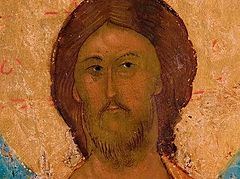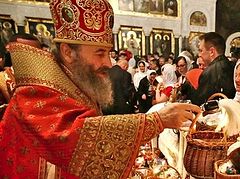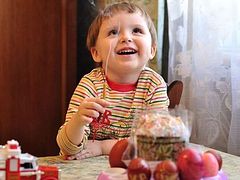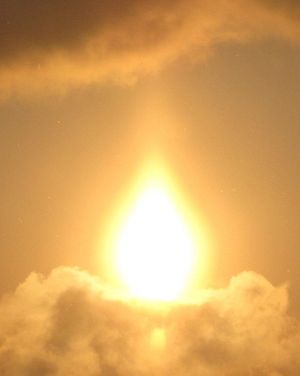 The Paschal Sun. Photo by O. Dursina When nature awakens from its winter sleep, the sky turns blue and the sun shines brighter, when the first green leaves appear in the trees and spring brooks begin to babble merrily, the most wonderful Orthodox feast—the Radiant Resurrection of Christ—comes to us. Christians hold this feast very dear, but all people feel special warmth and kindness on Pascha too. All of us have happy memories of our childhood—how we enjoyed “colored egg fights” [when players hit their eggs against each other and the owner of the last uncracked egg becomes the winner; this game is widespread in Russia.—Trans.], how we treated ourselves to delicious kulichi1 baked by our moms as well as sweet pascha cheese2! There is no church in my native village, so I first experienced the joy of being sprinkled with holy water and blessed by the priest in adulthood. Nevertheless little miracles always occurred on Pascha at home. Sometimes our family treasure—the centuries-old icon of the Holy Theotokos—began to glow with tiny dots of light; sometimes clouds with strange shapes appeared in the skies; sometimes the sun rose in an unusual way in the morning and “danced”, as my granny used to say. Several times I wanted to wake up on Pascha as early as possible to see these phenomena with my own eyes, but I couldn’t. However, once I did…
The Paschal Sun. Photo by O. Dursina When nature awakens from its winter sleep, the sky turns blue and the sun shines brighter, when the first green leaves appear in the trees and spring brooks begin to babble merrily, the most wonderful Orthodox feast—the Radiant Resurrection of Christ—comes to us. Christians hold this feast very dear, but all people feel special warmth and kindness on Pascha too. All of us have happy memories of our childhood—how we enjoyed “colored egg fights” [when players hit their eggs against each other and the owner of the last uncracked egg becomes the winner; this game is widespread in Russia.—Trans.], how we treated ourselves to delicious kulichi1 baked by our moms as well as sweet pascha cheese2! There is no church in my native village, so I first experienced the joy of being sprinkled with holy water and blessed by the priest in adulthood. Nevertheless little miracles always occurred on Pascha at home. Sometimes our family treasure—the centuries-old icon of the Holy Theotokos—began to glow with tiny dots of light; sometimes clouds with strange shapes appeared in the skies; sometimes the sun rose in an unusual way in the morning and “danced”, as my granny used to say. Several times I wanted to wake up on Pascha as early as possible to see these phenomena with my own eyes, but I couldn’t. However, once I did…
Pascha was early in that year (in April). According to our family tradition, we were waiting for guests for Pascha, so I got up early to prepare for our visitors. The sun had not come out yet, so I decided to watch the sunrise. I took my camera and stood by the window, waiting for the sun to appear.
Little by little the sky lightened. Spectacular clouds lay beneath. At last the first rays of the sun struggled through them. The sun was rising slowly, leisurely, as if giving me a chance to capture its rising in all its glory. And there was a lot to admire! First the solar disk stretched upwards, resembling a huge candle and aiming high up in the sky. Then the sun hid behind the clouds, and a giant beaming cross appeared in the heavens for a moment. I couldn’t help but remember the real meaning of Pascha—the Resurrection of Jesus Christ Who gave humanity the path to salvation! After that the rising sun took the shape of an oval that resembled a Paschal egg. The sun was playing, glittering like gold up in the skies! All these transformations were taking place in peace and quiet; this sight automatically filled me with awe and tender emotion, and a thanksgiving prayer came out from the depths of my heart… At last the bright Paschal sun shot up from behind the clouds solemnly and merrily!
Christ Is Risen! In Truth He Is Risen! And all of nature silently repeats these words after people, welcoming God’s Resurrection.
This is followed by the preparations for the holiday, the blessing of kulichi and eggs, the joy of a clear spring day, our dearest guests at the table, presents, and the celebration of Holy Pascha. And I remained joyful and thankful to God all the rest of the day for the miracle I had seen. Glory to God for all things!
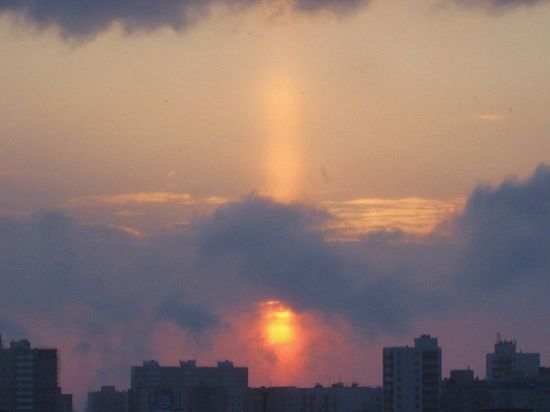 The sunrise on Pascha. Photo by O. Dursina
The sunrise on Pascha. Photo by O. Dursina
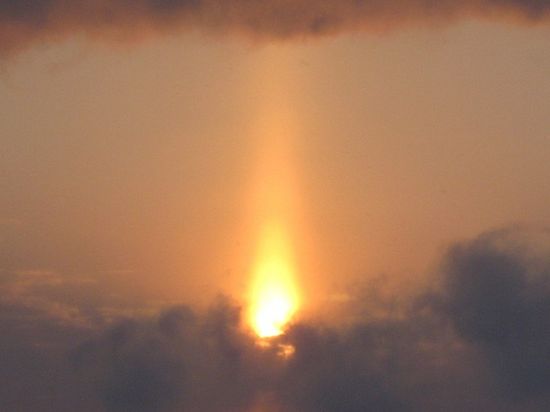 The rising sun in the shape of a candle flame. Photo by O. Dursina
The rising sun in the shape of a candle flame. Photo by O. Dursina

